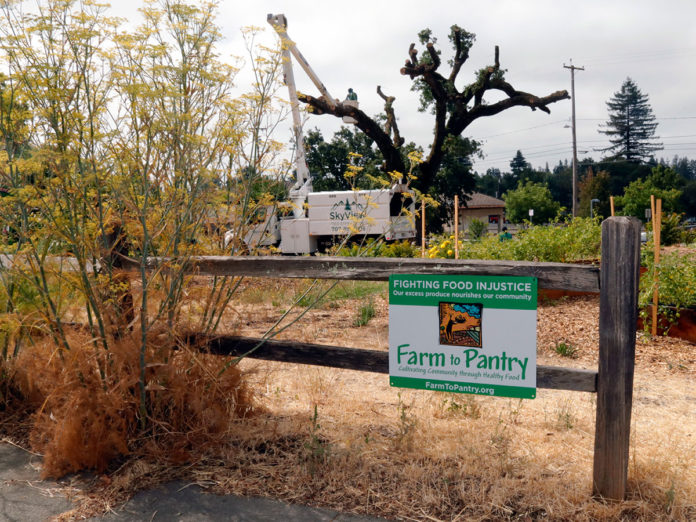
A joint community-county plan to allocate a third of an acre for a produce garden in Healdsburg got underway this spring, but not before it hit a snag: A tree that started growing in the 19th century had to be removed, disappointing residents who had hoped to save the heritage oak.
A four-man crew from Skyview Tree Experts showed up at 8am on Monday, July 29, to begin work on taking down the old valley oak. A worker in a basket boom armed with a chainsaw lopped off increasingly thick branches from the top and sides. Finally the main trunk was cut into sections, and the root ball ground into chips and sawdust. The project took all day.
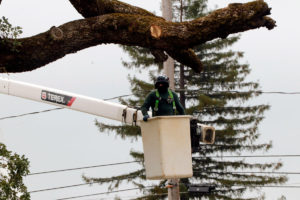
When the trunk was exposed at ground level, a thriving hive of ants was revealed, the source of the damage that compelled Sonoma County, the property’s owner, to order the tree’s removal—after no fewer than four arborists weighed in on the viability of the enormous tree, on the county-owned lot at 310 Mason St., at the corner of Fitch.
The tree itself, more than 50 feet tall and with a diameter of about 10 feet at breast height, easily qualified as a heritage oak, and fell under Sonoma County’s new Tree Ordinance. And since the 17,000-square-foot lot is a parcel of county property inside the city limits, the county bears responsibility for the tree’s fate.
With the planned increase in human use of the lot, the county reluctantly decided it had to go. Despite its heritage tree status, “There isn’t a prohibition on cutting down trees when they pose a significant safety risk,” Williams said.
Garden Spot
The lot is being developed as a community garden, in conjunction with an alliance of several local organizations including Farm to Pantry, Farm to Fight Hunger and Jardin del Pueblo.
“At the beginning of the year, we discussed a collaboration between the County of Sonoma and District 4’s office in which we would lease a vacant county-owned lot at 310 Mason St. to Farm to Pantry, a nonprofit, in order to grow produce for the community,” said Kasey Williams, a spokesman for the Department of Public Infrastructure (formerly Transportation and Public Works).
The lot has been fenced off for years, used primarily for equipment staging. It is located between Mason and Hudson, across the street from the depot that will come into use in the coming years as Healdsburg’s SMART station.
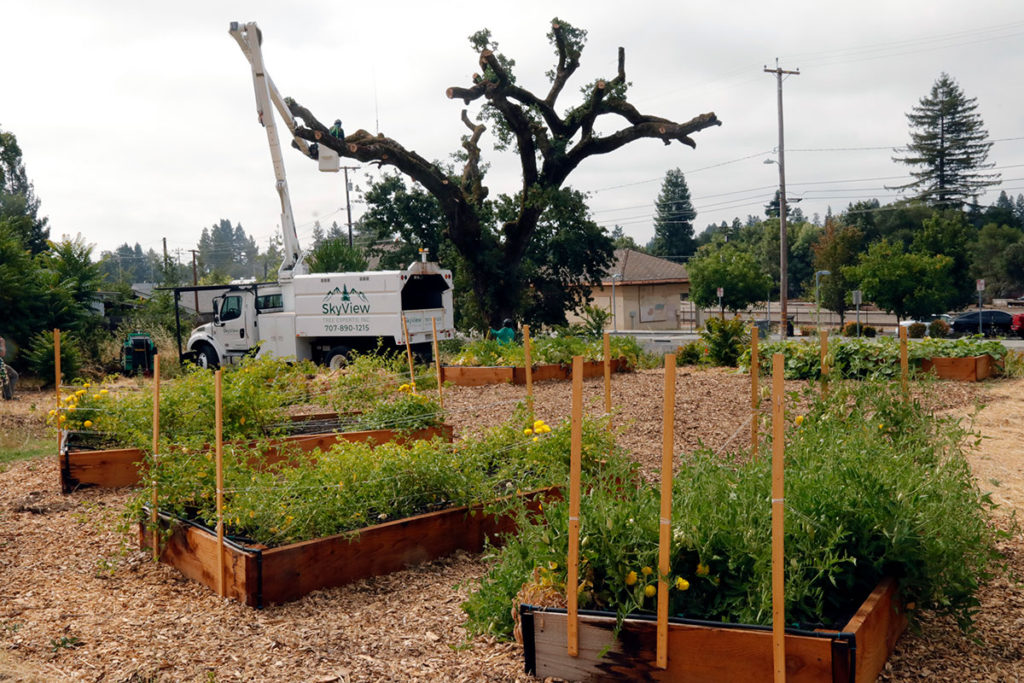
“We’ve made minor improvements to the lot [e.g. a water main, tree/fence removal, weeding and more] in order to get it ready for growing in the ground. Last step is a clear soil sample result to give them the green light to plant,” continued Williams. The terms of the just-executed lease agreement are extremely favorable, about $150/year.
The garden project is expected to provide a significant amount of fresh produce to an underserved community in the county, and to offer the opportunity for members of that community—many of whom are farmworkers—to have a garden of their own to work.
Already a number of planter boxes are set up in the lot, with flowers, peppers, herbs and vegetables in healthy summer growth. Eventually in-ground gardens will be developed as well, once the county concludes the soil sample testing to verify the safety of grown food.
Rosa Gonzales, the newly-named executive director of Farm to Pantry (she replaces Duskie Estes who left earlier this year), was brought up-to-speed on the Mason Street project when she arrived earlier this year from an interim job back East.
“I honestly think it stemmed from seeing that out in the community, a lot of the families, a lot of the people who are working the land and who are providing the food for the rest of us, do not have access to land to grow their own food,” Gonzales said.
“It’s kind of taking community gardens to a whole new level. Anyone who is a resident of Healdsburg who needs the food, can have the food,” she added.
Farm to Pantry has a number of so-called “Farmacy Carts” in operation that offer produce for community members whose diet may not have enough fresh produce for optimal health. One such cart is in town at Alliance Medical Center, while a dozen others reside in the northern Sonoma County area.
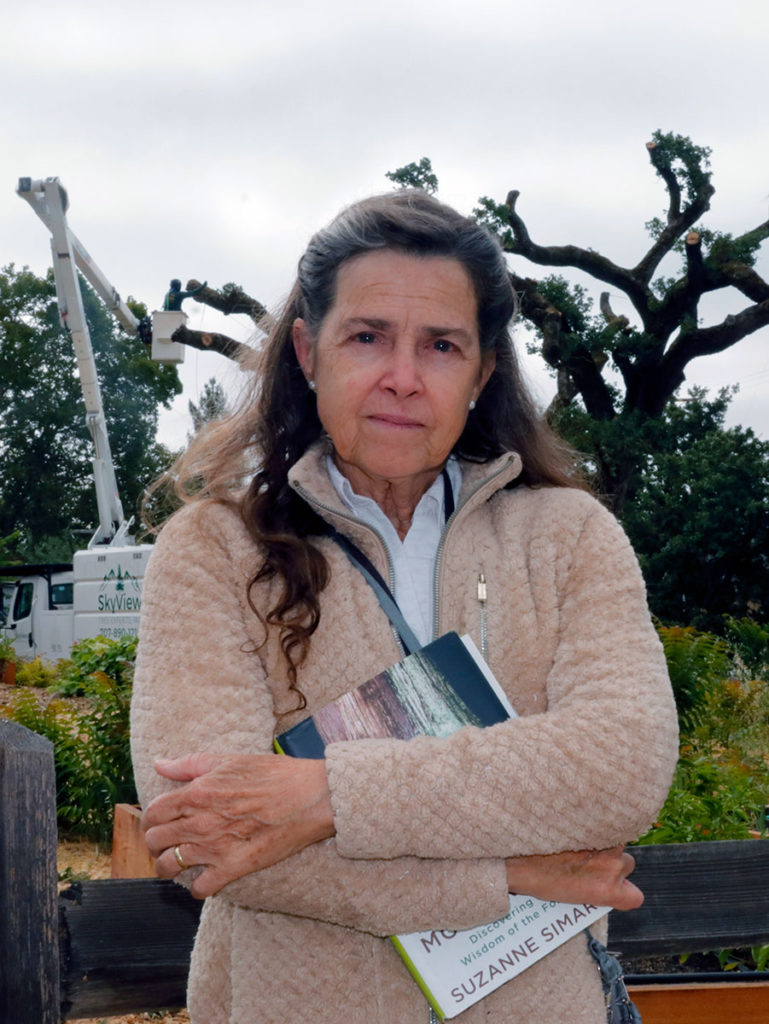
Mother Tree
“This is a sad day because this tree’s been here since the 1800s,” said Kimberly Burr of Forests Unlimited, who sorrowfully watched the dismemberment of the tree. “It’s just climate-smart policy to change the way we value trees.”
She held in her arms her a copy of Suzanne Simard’s Finding the Mother Tree, a book that carried forward Simard’s theory that trees have much more collective intelligence than formerly recognized—and the “mother tree” was the hub of a complex, subterranean network of fungi she called the “Wood Wide Web.”
The scientist provided inspiration for Richard Powers’ Pulitzer Prize-winning novel, The Overstory.
Burr referred to the tall, complexly branched tree on Hudson Street as a mother tree, and sadly noted that all of its progeny save one, a 12-foot sapling, were being removed as well.
Burr was not the only friend of the oak to witness all or part of the tree’s removal. Janice Watkins and Ty Benoit, both of Healdsburg, had shown up earlier in the day. “The updated tree protection ordinance is too vague and nonspecific to protect this tree. This tree has years of life left,” Watkins said.
“When I think of all the forests that have been destroyed and are still under threat because of the wildfires in the West, the climate grief becomes overwhelming,” Benoit said. “I believe we could have found a way to save this tree and simultaneously protect the humans who came close to it.”
Despite the ambiguity about the tree’s longevity—to the untrained eye it looked healthy, though several cables had been installed to hold the spreading limbs in place—the county bears responsibility for public safety on its property, and accepts responsibility for the tree’s removal.
“Now that we just have increased traffic on the lot, essentially this lot’s going to be functioning like a public park,” Williams said. “So our county counsel had concerns about it … And when we got those four arborist reports, that pretty much confirmed our suspicions.”
Still, striking a positive note, Williams said, “I consider this project to be pretty unique and a rare example of what could be considered a good use of public funds and public property.”



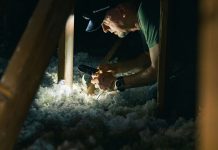
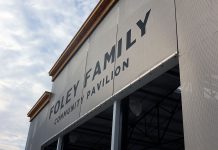




This lot, which had the old and now gone oak tree, is just a few blocks from our house. I had no idea that the county owned the lot. How did that happen? Do reporters ever tell the whole story anymore?
The backstory is just as important as the current story.
https://www.youtube.com/watch?v=mZDol3pHkMI
The above video link shows the causes of the horrible wildfires in the forests. The solution is private ownership of the forests. Weyerhauser and Plum Creek take care of their forest land in Washington State. The Forest Service land is clearcut and destroyed. The government doesn’t maintain its land. They don’t care. They don’t have to.
Watch the video.